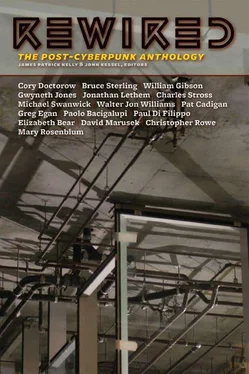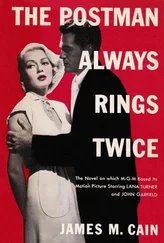So the ring knew exactly what was in my blood. It also knew what belonged, and what didn’t. Under its relentless scrutiny, the biochemical signature of a viral or bacterial infection, or even a microscopic tumour far downstream, could never escape detection for long — and once a diagnosis was made, treatment was almost instantaneous. Planted alongside the sensors were programmable catalysts, versatile molecules that could be reshaped under computer control. The ring could manufacture a wide range of drugs from raw materials circulating in the blood, just by choosing the right sequence of shapes for these catalysts — trapping the necessary ingredients together in nooks and crannies moulded to fit like plaster casts around their combined outlines.
With medication delivered within minutes or seconds, infections were wiped out before they could take hold, tiny clusters of cancer cells destroyed before they could grow or spread. Linked by satellite to a vast array of medical databases, and as much additional computing power as it required, the ring gave me a kind of electronic immune system, fast enough and smart enough to overcome any adversary.
Not everyone on the beach that morning would have had their own personal HealthGuard, but a weekly session on a shared family unit, or even a monthly check-up at their local GP, would have been enough to reduce their risk of cancer dramatically. And though melanoma was the least of my worries — fair-skinned, I was covered in sunscreen as usual; fatal or not, getting burnt was painful — with the ring standing guard against ten thousand other possibilities, I’d come to think of it as a vital part of my body. The day I’d installed it, my life expectancy had risen by fifteen years — and no doubt my bank’s risk-assessment software had assumed a similar extension to my working life, since I’d be paying off the loan I’d needed to buy the thing well into my sixties.
I tugged gently at the plain metal band, until I felt a sharp warning from the needle-thin tubes that ran deep into the flesh. This model wasn’t designed to be slipped on and off in an instant like the shared units, but it would only take a five-minute surgical procedure under local anaesthetic to remove it. In Uganda, a single HealthGuard machine served 40 million people — or rather, the lucky few who could get access to it. Flying in wearing my own personal version seemed almost as crass as arriving with a giant solar tattoo. Where I was headed, cancer had very definitely not been defeated.
Then again, nor had malaria, typhoid, yellow fever, schistosomiasis. I could have the ring immunise me against all of these and more, before removing it … but the malaria parasite was notoriously variable, so constant surveillance would provide far more reliable protection. I’d be no use to anyone lying in a hospital bed for half my stay. Besides, the average villager or shanty-town dweller probably wouldn’t even recognise the thing, let alone resent it. I was being hypersensitive.
I gathered up my things and headed for the cycle rack. Looking back across the sand, I felt the kind of stab of regret that came upon waking from a dream of impossible good fortune and serenity, and for a moment I wanted nothing more than to close my eyes and rejoin it.
Lisa saw me off at the airport.
I said, “It’s only three months. It’ll fly past.” I was reassuring myself, not her.
“It’s not too late to change your mind.” She smiled calmly; no pressure, it was entirely my decision. In her eyes, I was clearly suffering from some kind of disease — a very late surge of adolescent idealism, or a very early midlife crisis — but she’d adopted a scrupulously nonjudgmental bedside manner. It drove me mad.
“And miss my last chance ever to perform cancer surgery?” That was a slight exaggeration; a few cases would keep slipping through the HealthGuard net for years. Most of my usual work was trauma, though, which was going through changes of its own. Computerised safeguards had made traffic accidents rare, and I suspected that within a decade no one would get the chance to stick their hand in a conveyor belt again. If the steady stream of gunshot and knife wounds ever dried up, I’d have to retrain for nose jobs and reconstructing rugby players. “I should have gone into obstetrics, like you.”
Lisa shook her head. “In the next twenty years, they’ll crack all the molecular signals, within and between mother and foetus. There’ll be no premature births, no Caesareans, no complications. The HealthGuard will smooth my job away, too.” She added, deadpan, “Face it, Martin, we’re all doomed to obsolescence.”
“Maybe. But if we are…it’ll happen sooner in some places than others.”
“And when the time comes, you might just head off to some place where you’re still needed?”
She was mocking me, but I took the question seriously. “Ask me that when I get back. Three months without mod cons and I might be cured for life.”
My flight was called. We kissed goodbye. I suddenly realised that I had no idea why I was doing this. The health of distant strangers? Who was I kidding? Maybe I’d been trying to fool myself into believing that I really was that selfless — hoping all the while that Lisa would talk me out of it, offering some face-saving excuse for me to stay. I should have known she’d call my bluff instead.
I said plainly, “I’m going to miss you. Badly.”
“I should hope so.” She took my hand, scowling, finally accepting the decision. “You’re an idiot, you know. Be careful.”
“I will.” I kissed her again, then slipped away.
I was met at Entebbe airport by Magdalena Iganga, one of the oncologists on a small team that had been put together by Médecins Sans Frontières to help overburdened Ugandan doctors tackle the growing number of Yeyuka cases. Iganga was Tanzanian, but she’d worked throughout eastern Africa, and as she drove her battered ethanol-powered car the thirty kilometres into Kampala, she recounted some of her brushes with the World Health Organisation in Nairobi.
“I tried to persuade them to set up an epidemiological database for Yeyuka. Good idea, they said. Just put a detailed proposal to the cancer epidemiology expert committee. So I did. And the committee said, we like your proposal, but oh dear, Yeyuka is a contagious disease, so you’ll have to submit this to the contagious diseases expert committee instead. Whose latest annual sitting I’d just missed by a week.” Iganga sighed stoically. “Some colleagues and I ended up doing it ourselves, on an old 386 and a borrowed phone line.”
“Three eight what?”
She shook her head. “Palaeocomputing jargon, never mind.”
Though we were dead on the equator and it was almost noon, the temperature must have been 30 at most; Kampala was high above sea level. A humid breeze blew off Lake Victoria, and low clouds rolled by above us, gathering threateningly then dissipating, again and again. I’d been promised that I’d come for the dry season; at worst there’d be occasional thunderstorms.
On our left, between patches of marshland, small clusters of shacks began to appear. As we drew closer to the city, we passed through layers of shanty towns, the older and more organised verging on a kind of bedraggled suburbia, others looking more like out-and-out refugee camps. The tumours caused by the Yeyuka virus tended to spread fast but grow slowly, often partially disabling people for years before killing them, and when they could no longer manage heavy rural labour, they usually headed for the nearest city in the hope of finding work. Southern Uganda had barely recovered from HIV when Yeyuka cases began to appear, around 2013; in fact, some virologists believed that Yeyuka had arisen from a less virulent ancestor after gaining a foothold within the immune-suppressed population. And though Yeyuka wasn’t as contagious as cholera or tuberculosis, crowded conditions, poor sanitation and chronic mal-nourishment set up the shanty towns to bear the brunt of the epidemic.
Читать дальше












